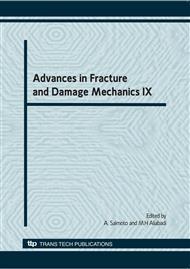p.225
p.229
p.233
p.237
p.241
p.245
p.249
p.253
p.257
Thermal Stress Analysis for Shrink Fitting System Used for Ceramics Conveying Rollers in the Process of Separation
Abstract:
Steel conveying rollers used in hot rolling mills must be exchanged very frequently at great cost because hot conveyed strips induce wear on the surface of roller in short periods. In this study, new roller structure is considered which has a ceramics sleeve connected with two short steel shafts at both ends by shrink fitting. Here, the ceramics sleeve may provide longer life and reduces the cost for the maintenance. However, sometimes the steel shaft has to be pulled out for exchange. Simply, heating outside surface and cooling inside surface of the shaft are necessary for separation. However, attention should be paid to the maximum thermal stress of the ceramics sleeve in the process of separation. In this paper, finite element method analysis is applied to the structure and thermal stress has been calculated with the varying dimensions of the structure. Also several effects on thermal stress have been investigated, such as the effect of shrink fitting ratio, outside diameter, the fitted length, thickness of shaft, materials an so on. Finally the most appropriate thermal conditions to reduce maximum stress and make separation easy have been discussed, which is very useful for designing of new rollers.
Info:
Periodical:
Pages:
241-244
Citation:
Online since:
November 2010
Authors:
Keywords:
Price:
Сopyright:
© 2011 Trans Tech Publications Ltd. All Rights Reserved
Share:
Citation:


